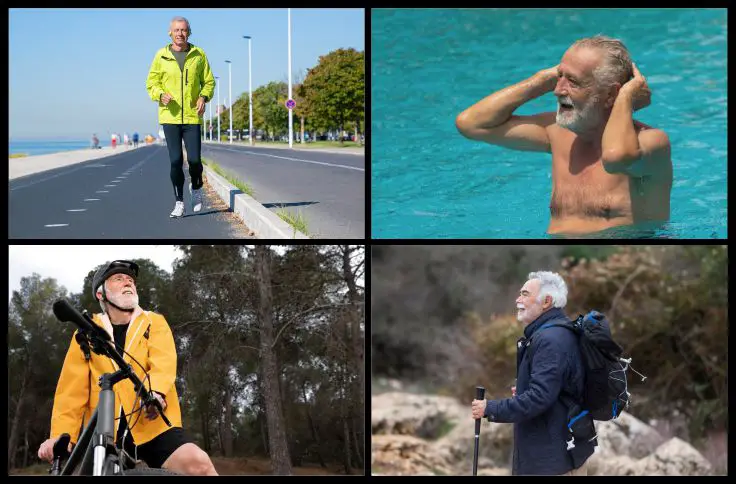Last updated on April 13th, 2025 at 04:50 pm
Feeling sluggish or out of breath too easily? Discover cardio workouts for older men that are safe, effective, and energizing, designed to restore vitality and boost heart health naturally.
You’re not just trying to stay in shape, you want to feel strong, alert, and ready for each day with a body that agrees with admirable fashion and style.
As you grow older, your body changes, and so should the way you train.
Cardio workouts for older men are more than just movement, they help keep your heart steady, your energy up, and your mind clear.
When done right, they support blood flow, ease joint stiffness, and help you manage your weight without straining your body.
You don’t need to train like you’re in your twenties. You need routines that match your pace but still push you enough to stay sharp.
From walking and cycling to swimming and dancing, there’s something that fits your rhythm.
Let’s break down the cardio routines that work best for men like you, ones that are safe, effective, and built to keep you going.
Recommended: Guide to Older Men’s Fitness Routine
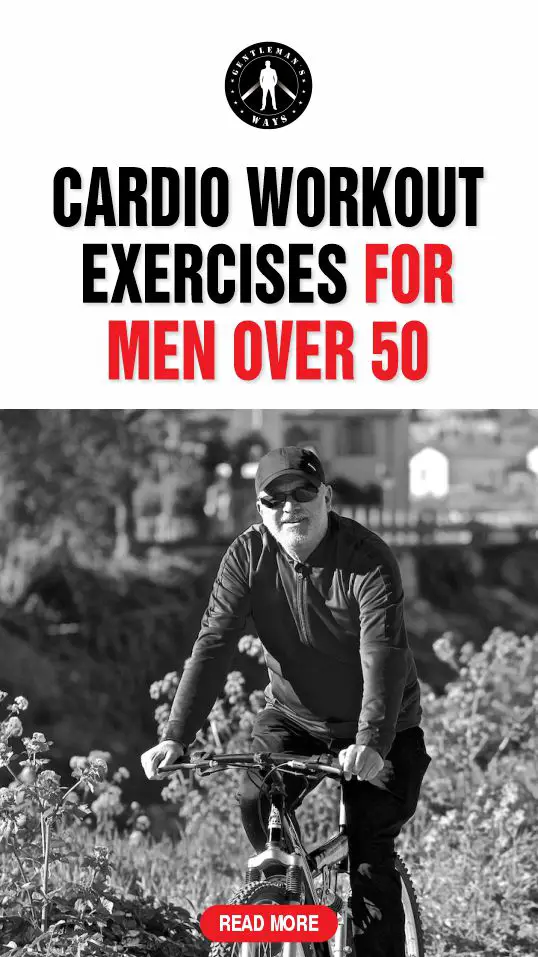
Table of Contents
- Main Points
- What is Cardio?
- The Benefits of Cardio for Men Over 50
- Choosing the Right Cardio Exercises for Older Men
- Top Cardio Workouts for Older Men
- How to Start and Stay Safe
- Weekly Cardio Schedule for Older Men
- Tips to Stay Consistent and Motivated
- Frequently Asked Questions
Main Points
- Cardio workouts for older men protect the heart, enhance circulation, and reduce risks of cardiovascular issues with consistent, age-appropriate movement.
- Regular cardiovascular workouts for men over 50 support weight management, reduce belly fat, and regulate blood sugar without intense or painful effort.
- Cardio exercises like swimming and walking ease joint stiffness, improve balance and reduce the risk of falling with age.
- Dance and low-impact cardio workouts lift mood, reduce stress, and help sharpen mental clarity naturally and enjoyably.
Recommended: The Basics of Men’s Health and Wellness
What is Cardio?
Cardio, or cardiovascular exercise, gets your heart pumping and keeps it steady for a while. It trains your heart and lungs to work better and helps your blood move smoothly through your body.
This type of movement includes walking, cycling, swimming, dancing, jogging, and using machines like treadmills, bikes, or ellipticals.
For older men, cardio plays a big role in keeping your weight in check, keeping your energy up, and lowering your risk of heart problems.
Recommended: Exercises for Balance and Flexibility for Senior Men
The Benefits of Cardio for Men Over 50
As aging progresses, staying active is one of the best choices you can make for your body and mind as an older man.
If you’ve been thinking about adding cardio to your routine, now’s the time. Here’s what regular cardio can do for you:
Protect Your Heart
Your heart works hard for you every day. Cardio helps it do its job better. When you move, whether it’s walking, cycling, swimming, or dancing, your heart gets stronger.
Your blood pressure stays in check, your circulation improves, and your body gets the oxygen it needs.
That means more energy, less strain on your heart, and a lower risk of heart disease.
Manage Your Weight Without Overthinking It
Let’s be real: metabolism doesn’t work like it used to. But cardio can help. Regular movement burns calories, helps keep belly fat off, and makes it easier to maintain a healthy weight.
You don’t need to overdo it. A brisk walk each day can already make a difference.
Keeping your weight in check also helps avoid issues like high blood sugar and blood pressure.
Recommended: Functional Fitness Exercises for Senior Men
Move Better and Stay Balanced
You might notice your joints feeling stiff or your balance a bit off. That’s normal with age, but cardio helps.
Low-impact exercises like swimming or walking are gentle on your joints and help you stay flexible. Better balance also means fewer chances of falling. And falls?
They’re one of the biggest threats to your independence as you get older.
Lift Your Mood Without a Prescription
You know those days when your energy’s low and everything feels like a chore? Cardio helps fix that. Moving your body boosts feel-good chemicals in your brain.
You feel more awake, less stressed, and more like yourself. Even 20 minutes a day can help reduce anxiety and lift your mood naturally.
Keep Your Mind Sharp
Forgetfulness can creep in over time, but you don’t have to just accept it. Studies show that cardio helps improve memory and focus.
It gets more blood flowing to your brain and supports long-term brain health.
You’ll think clearer, stay more alert, and keep your mind working the way you want it to.
Related: Resistance and Strength Training for Older Men
Choosing the Right Cardio Exercises for Older Men
As you grow older, staying active isn’t a luxury, it’s a necessity. Cardio keeps your heart strong, boosts your energy, and helps you move with ease.
But not every workout suits everybody, especially as the years go by.
Low-Impact vs High-Impact: Know What Works for You
Not all cardio is equal. You need exercises that work with your body, not against it.
Low-impact exercises are easier on your joints. These are your go-to if you deal with stiffness or joint pain:
- Walking: A great way to stay active without strain
- Cycling: Smooth movement that keeps your knees safe
- Swimming: Full-body movement with zero pressure on joints
High-impact exercises put more pressure on your knees, hips, and ankles. These include:
- Running: Great for stamina but tough on your knees
- HIIT: Builds endurance fast but can be risky without proper form or prep
You don’t have to avoid high-impact workouts entirely, but check in with yourself. Do your knees ache after a jog? Does jumping leave you sore for days?
Then it’s time to shift your routine. If you’re unsure, ask your doctor or a fitness expert before diving in.
Make Your Routine Work for You
Doing the same thing every day? That gets boring—and it can lead to injury.
Mix it up:
- Swim one day
- Go for a bike ride the next
- Take a brisk walk on the weekend
Changing your cardio routine keeps things fresh and trains different muscles. It also keeps your motivation up, which makes it easier to stick with your goals.
Listen to Your Body and Be Consistent
You don’t need to push hard to get results. The goal is to move often and feel good doing it.
Start with 20 to 30 minutes a day, even if it’s just a walk around your block. Pay attention to how your body feels. Soreness that goes away is normal. Pain that sticks around isn’t.
A Few Tips Before You Start
- Talk to your doctor if you have medical conditions or haven’t exercised in a while
- Choose shoes that support your feet
- Stay hydrated
- Warm up before and cool down after your workouts
Takeaway: The best cardio workout is the one you can keep doing. Pick what feels good, change it up when needed, and stay consistent.
You’re not just adding years to your life, you’re adding life to your years.
Further Reading: Health Screenings Every 60s Man Should Get
Top Cardio Workouts for Older Men
Staying active helps you keep your heart strong, your joints moving, and your energy up. If you’re an older man, cardio workouts don’t have to be intense to be effective.
You just need the right mix of safety, movement, and routine.
Here are seven cardio workouts that work well for older adults. Pick what fits your pace and interests.
1. Brisk Walking
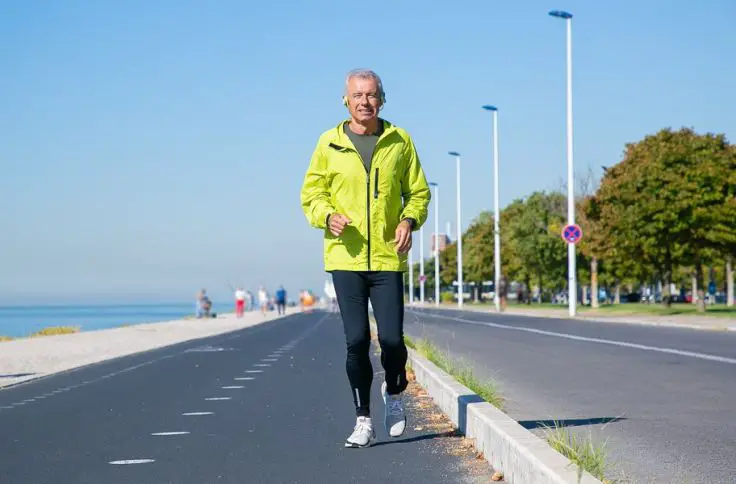
Walking is one of the easiest ways to stay active as you age. A brisk pace improves circulation, strengthens your heart, and keeps your joints moving without impact.
Just 20 to 30 minutes a day can help manage weight, lower blood pressure, and boost your energy.
It’s also great for mental clarity. Try walking in the morning to start your day fresh, or after dinner to improve digestion.
Keep it interesting by changing routes or walking with a buddy. Good walking shoes with arch support are key.
If you’re starting from a sedentary lifestyle, go slow and increase your speed over time. Aim for steady steps and swing your arms naturally.
Your body responds well to consistent movement—it doesn’t need to be complicated.
2. Cycling
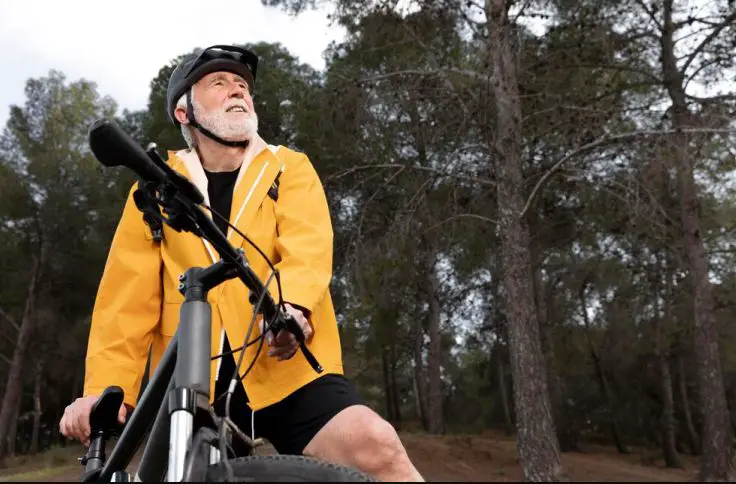
Cycling is a heart-friendly way to boost stamina and strengthen your lower body. It’s gentle on the knees, making it ideal for men dealing with joint issues or past injuries.
Indoor cycling lets you avoid traffic and bad weather, while outdoor riding brings fresh air and variety.
Start slow on a stationary bike to build confidence, then progress to scenic bike trails if you’re comfortable.
Keep your posture upright and shoulders relaxed. Short rides a few times a week add up and can help with balance and coordination too.
Always wear a helmet outdoors and check that your seat and handlebars are adjusted to fit your body.
Whether you’re watching TV indoors or cruising a park path, cycling keeps your heart and legs in sync.
Recommended: Longevity: 5 Healthy Habits that Will Give You a Leap
3. Swimming and Water Aerobics
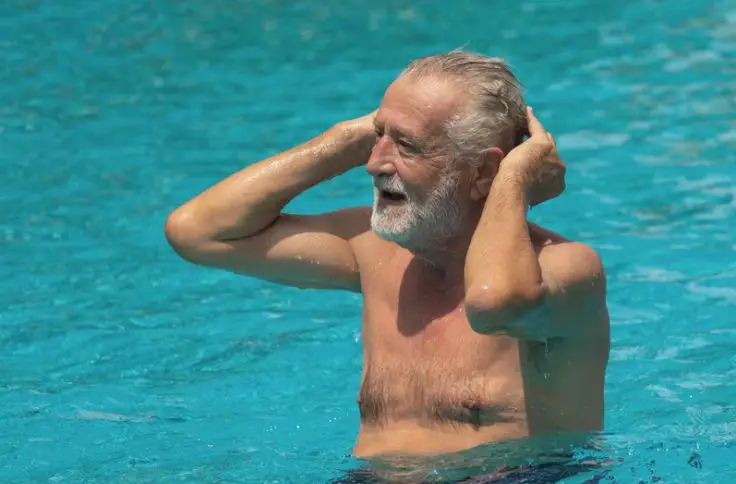
Swimming is one of the best full-body cardio workouts for older men. It protects your joints while keeping your muscles engaged.
You can swim laps at a steady pace to build endurance or join a water aerobics class for structured low-impact movement.
The water’s resistance gently works your muscles, while the buoyancy relieves pressure on your back, knees, and hips.
It’s especially helpful if you have arthritis or stiffness. Start with simple water walking in waist-deep water to get used to the feel.
Many community centers and gyms offer senior-friendly classes. Don’t worry if you’re not a strong swimmer, there’s a level for everyone.
Plus, being in the water naturally lowers stress levels and improves sleep quality. Just don’t forget to stay hydrated.
4. Elliptical Training
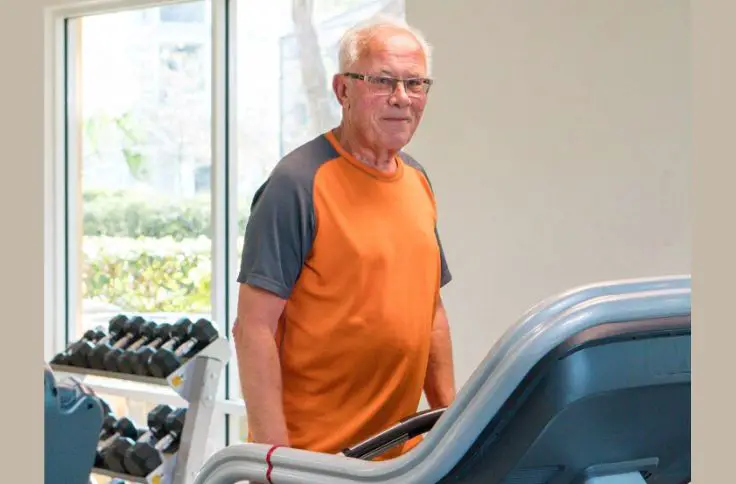
If you want the benefits of running without the joint pain, an elliptical machine is your go-to.
It simulates walking or jogging, but your feet stay on the pedals, removing harsh impact.
You work both your upper and lower body while keeping your heart rate up.
Start at a low resistance and increase as you feel more confident. Watch your posture—stand tall, hold the handles, and move with a smooth rhythm.
Don’t rush; a steady pace keeps it safe and effective.
Try using intervals: 2 minutes of gentle effort, followed by 1 minute of moderate resistance.
Most gyms have ellipticals, and many now include virtual trails for a more engaging session. This machine is perfect for men wanting cardio without stressing knees or hips.
Recommended: 11 Common Fears of Older Gentlemen
5. Rowing Machines
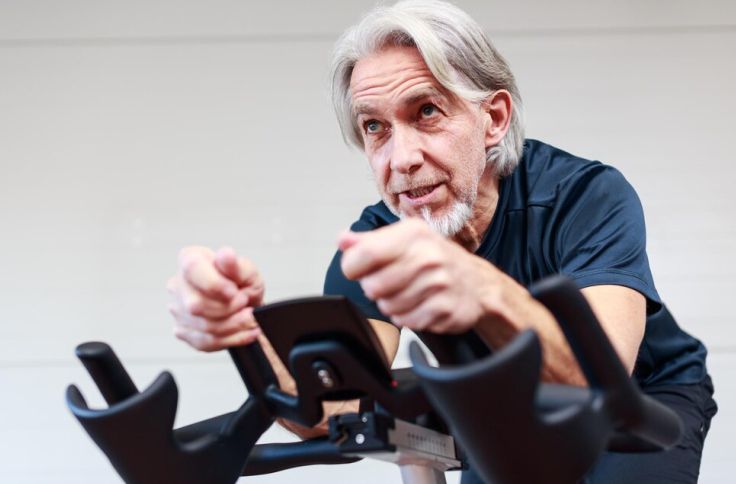
Rowing is a solid choice if you’re looking to build strength and get your heart rate up in one workout. It works your legs, back, arms, and core with each stroke.
But the key is in your form, keep your back straight, push with your legs, then pull with your arms.
Start with 5 to 10 minutes at a low resistance and gradually build from there. A steady pace is safer and just as effective.
Avoid jerky movements, which can strain your lower back. Many rowers have built-in programs to guide your sessions.
It’s a great indoor option for rainy days or colder months. If you’re aiming for cardio and strength in one, this is a powerful way to get both with minimal joint stress.
6. Dance-Based Workouts
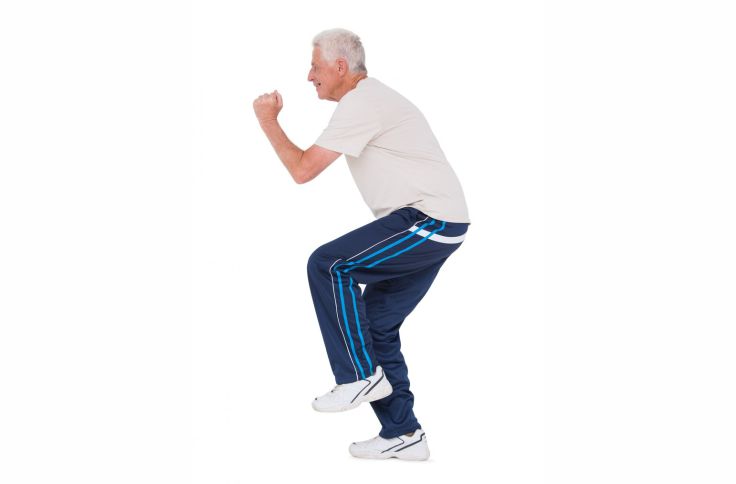
Dancing doesn’t feel like exercise, and that’s the point. It’s movement, rhythm, and fun all rolled into one.
For older men, it’s a great way to improve coordination, heart health, and flexibility.
Choose styles that match your personality, Zumba, swing, ballroom, or even line dancing.
You’ll move more than you think, and the music makes it easier to stick with. These workouts are also a great way to stay social.
Many community centers offer beginner-friendly classes, and you can also follow along with online videos at home.
The best part? You control the pace. Listen to your body and take breaks when you need to.
Dance is proof that cardio doesn’t have to feel like a chore—it can be something you look forward to.
7. Hiking or Nature Walks

Spending time in nature while getting your steps in is a powerful way to recharge your body and mind.
Hiking and nature walks work your legs, boost your heart rate, and calm your nerves all at once.
Start with flat, short trails and work your way up to longer walks with gentle inclines.
Always wear supportive shoes and bring water, especially in warmer weather. Use walking poles if you want extra balance or support.
Walking outdoors also helps with balance and coordination, which naturally decline with age.
You don’t have to go deep into the woods, your local park or garden trail works fine. Try walking early in the morning or during cooler hours for comfort.
Nature has a way of clearing your head while keeping your body active.
How to Start and Stay Safe
Starting a cardio routine in your 50s, 60s, or beyond can help you stay strong, active, and independent. But before you lace up your shoes or hit the gym, safety comes first.
Here’s what you need to do to begin smart and stay protected.
Check With Your Doctor First
Don’t skip this step. Book an appointment and get the green light. A simple check-up helps rule out any heart conditions, high blood pressure, or other issues that might affect your workout.
Your doctor can also help you figure out the right intensity and type of exercise for your current health.
Always Warm Up and Cool Down
Never jump into a workout cold. Spend 5 to 10 minutes doing light movements like marching in place or arm circles.
This slowly raises your heart rate and gets your muscles ready. After your session, cool down with slower movements and some light stretching.
It helps prevent dizziness, stiffness, and next-day soreness.
Watch Your Heart Rate
Know your target heart rate and stay within it. For most older adults, that’s around 50% to 70% of your maximum heart rate (roughly 220 minus your age).
You can check your pulse at your wrist or neck, or use a basic heart rate monitor. If you’re gasping for breath, ease off. You should be able to talk but not sing.
Stay Hydrated
Your thirst cues fade with age, so don’t wait until you feel parched. Drink a glass of water before your workout.
Take small sips throughout, especially if you’re sweating. Afterward, drink again to help your body recover.
If you’re doing longer sessions, add a pinch of salt or drink something with electrolytes.
Wear the Right Shoes
Good shoes are non-negotiable. Choose ones made for walking, cycling, or gym workouts.
Look for support in the arch and cushioning in the heel. Shoes that fit well reduce your risk of falls, sprains, or long-term knee and back pain.
Know When to Stop
Pay attention to your body. Stop your workout if you feel chest pain, sudden weakness, dizziness, nausea, or any sharp discomfort.
Don’t push through pain, it’s a warning sign. If these symptoms don’t pass quickly, call for help.
Weekly Cardio Schedule for Older Men
Creating a cardio workout schedule tailored for older men involves understanding the importance of gradual progression, rest, and variety in exercises.
The following is a beginner-friendly 7-day cardio schedule designed to accommodate various fitness levels while focusing on safety and effectiveness.
- Day 1: Walking: Start the week with a brisk 30-minute walk in a local park or neighborhood. Walking is a low-impact activity that enhances cardiovascular health without putting undue strain on the joints. Adjust the pace as needed, ensuring it feels comfortable yet slightly challenging.
- Day 2: Cycling: Engage in a 30-minute cycling session, either on a stationary bike or outdoors. Cycling is an excellent way to improve leg strength and cardiovascular endurance. Maintain a steady pace and enjoy the scenery if cycling outside.
- Day 3: Rest Day: It’s vital to include designated rest days to allow the body to recover. Utilize this day for gentle stretching or light yoga to promote flexibility and maintain mobility.
- Day 4: Swimming: Participate in a low-impact swim session for 20 to 30 minutes. Swimming is an ideal cardio workout for older men, as it minimizes joint stress while providing a full-body workout. Aim for a mix of freestyle and backstroke to keep things interesting.
- Day 5: Interval Training: Practice a low-intensity interval workout, alternating between walking for 1 minute and a moderate pace for 2 minutes, for a total of 30 minutes. This approach can enhance cardiovascular fitness without overwhelming the body.
- Day 6: Group Class: Join a fitness class aimed at seniors, such as low-impact aerobics or dance. This not only keeps workouts engaging but also offers a social outlet that can motivate older men to stay active.
- Day 7: Light Stretching or Rest: Conclude the week with gentle stretching exercises or additional rest. This helps to promote recovery and prepares the body for the upcoming week of activities. Flexibility exercises can reduce muscle soreness and enhance mobility.
Overall, this sample weekly cardio schedule encourages older men to engage in various activities that are manageable, safe, and effective for maintaining physical fitness and overall well-being.
Tips to Stay Consistent and Motivated
Sticking with a cardio routine gets easier when you make it work for your life, not the other way around. Here’s how you can keep showing up, without forcing it.
Set Goals That Fit Your Life
Start small. Maybe it’s 15 minutes of brisk walking three times a week. Maybe it’s riding your bike on weekends. Write it down.
Short-term goals that match your fitness level are easier to hit, and each win builds your confidence. Over time, these small steps turn into a routine that feels natural.
Try this:
- Weekly target: Walk 3 times for 20 minutes
- Monthly goal: Increase your time or distance slightly
- Keep it flexible: Skip guilt if you miss a day. Just pick it back up
Track Your Progress
Don’t leave your progress to memory. Use a simple notebook or a free app to track how often you move, what you do, and how you feel.
This helps you spot patterns, and what’s working and what isn’t. And on low-energy days, it reminds you how far you’ve come.
Track this:
- Activity type and duration
- Distance or steps
- Mood or energy after the workout
Even a calendar with checkmarks can work. Seeing a streak builds motivation.
Make It Social
You’re more likely to stick with exercise when someone’s counting on you.
Walking with a neighbor, biking with a buddy, or joining a class adds something extra: connection.
It makes workouts feel less like a chore and more like time well spent.
Try this:
- Join a local walking or hiking group
- Attend a senior-friendly fitness class
- Ask a friend or family member to join your routine
You’ll move more, laugh more, and stay on track.
Keep It Enjoyable
Cardio doesn’t have to be boring. Choose what feels good and fits your pace.
You might like walking in the park, dancing in your living room, or swimming at your local pool.
When you enjoy what you’re doing, motivation shows up without being forced.
Keep things fresh:
- Rotate activities so you don’t get bored
- Reward yourself with something small after hitting a goal
- Listen to music or audiobooks while you move
Frequently Asked Questions
Feeling sluggish or out of breath too easily?
Discover cardio workouts for older men that are safe and energizing. They improve stamina, support heart health, and boost vitality, helping you feel alert and ready each day.
What’s the best beginner cardio for older men?
Brisk walking is ideal, low-impact, simple, and effective. Start with 20 minutes daily to boost energy, support joints, and build a habit without overexerting yourself.
Can cardio help me stay mentally sharp?
Yes! Cardio increases blood flow to your brain, improving memory and focus. It helps reduce cognitive decline, keeping your mind alert and responsive as you age.
How do I avoid injury with cardio workouts?
Choose low-impact exercises like swimming or cycling. Warm up, wear proper shoes, and listen to your body to avoid strain and support long-term joint health.
References
- The many benefits of cardio workouts
- Overview on the older adult activity
- Guide on older adults’ activities
- The life-changing benefits of exercise after 60
Pyo Merez is a men’s lifestyle enthusiast and writer about the gentleman’s place and impact on society. Raised by a distinguished gentleman dad, he offers unique insights into how the mind of a gentleman works and how societal norms shape gentlemen’s identity and vice versa.
Through his insightful articles, Pyo taps into the depths of gentleman culture to provide perspectives on etiquette and manners in modern society.

